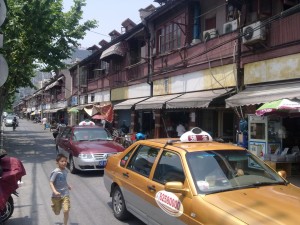Shanghai Street View: Traffic Triumph

As the latest heat wave shows no signs of easing its grip on Shanghai, our local officials are trying to provide some relief by releasing a report that shows how the city’s traffic has improved under a clean-up campaign that began in March. I was a bit skeptical on reading about the report, since it cited perceptions of improvement among city residents rather than focusing on actual numbers.
But then I thought about it some more, and realized that perceptions in this case may be equally or even more important than actual facts and figures. That’s because people’s perceptions of change are far more likely to affect their actual behavior than simply reading figures about growth in the number of tickets handed out for offences like jaywalking and running red lights.
At the same time, our city was tackling the traffic problem from another angle this week with its roll-out of new draft legislation that will toughen up existing traffic laws. The new legislation is still under discussion, and unfortunately doesn’t seem to include my dream of ending the practice of allowing cars to turn right at intersections when the traffic light is red.
But what did catch my attention was the new law’s attempt to stamp out a practice that allows drivers to let other people take demerits for their traffic violations, in an effort to avoid racking up too many violations. Such a practice could only happen in China, where it seems like black and gray markets evolve for just about anything.
All of that said, I have mostly praise for this prolonged campaign to tame our city’s traffic and make it more orderly and civilized. I was one of many skeptics when the campaign first launched back in March, when legions of police suddenly appeared on every street corner, often backed up by the more common traditional traffic assistants.
Such officers seemed a bit timid at first, often reluctant to confront drivers and pedestrians on a wide range of offenses that are quite common on our streets. But it does seem like they’ve become more assertive over time. And equally important, offenders also seem increasingly aware that they’ve actually violated the law, and thus are less inclined to protest at being punished for their behavior.
Improving Perceptions
That shift was reflected in results of the city’s latest survey, which showed that nearly 90 percent of Shanghai residents felt the number of traffic violations had dropped in the city since the launch of the campaign. The survey polled more than 1,700 people, who said they believed that offenses like illegal parking and jaywalking were down over the last four months.
I was skeptical at first that perhaps this survey was a way to hide real statistics that would show very little change had occurred as a result of the campaign. But it does seem almost inevitable that the number of citations has probably increased dramatically, simply because there are far more police on the street handing out tickets.
Then I thought about some of the subtle changes in my own behavior. One case that came to mind occurred just last weekend, when I was waiting to cross the street at an intersection of Nanjing Road in the Jing’an District. The light was red but no cars were coming, which normally would have prompted me to cross the street illegally.
But I didn’t feel any need for such haste that day, since I wasn’t in a hurry and such jaywalking would have saved me 20 or 30 seconds at most anyhow. That’s the kind of behavior modification the city needs on a mass scale to tame our overly aggressive drivers and pedestrians, and is clearly driven by people’s perception of what others are doing.
Meantime, the new traffic law now being drafted also looks set to contribute to our traffic cleanup, including far stiffer penalties for people who pay others to take demerits that could otherwise lead to suspension of their licenses. The new law would levy hefty fines of up to 20,000 yuan for all parties involved when drivers pay others to take their demerits. Such big sums are quite unusual in China, and would hopefully have more deterrent effect than the usual paltry fines of around 50 yuan or less for many offenses.
All of this shows that Shanghai really does seem intent on taming its unruly traffic, both from the driver and pedestrian perspectives, despite my earlier skepticism that the campaign would quickly disappear. Improvement was probably inevitable over the longer term, especially as our city becomes more affluent and international. But this addition of legal muscle to expedite the drive is a welcome acceleration of the trend, and should ultimately make our city far more livable and friendly for its millions of drivers and pedestrians.
